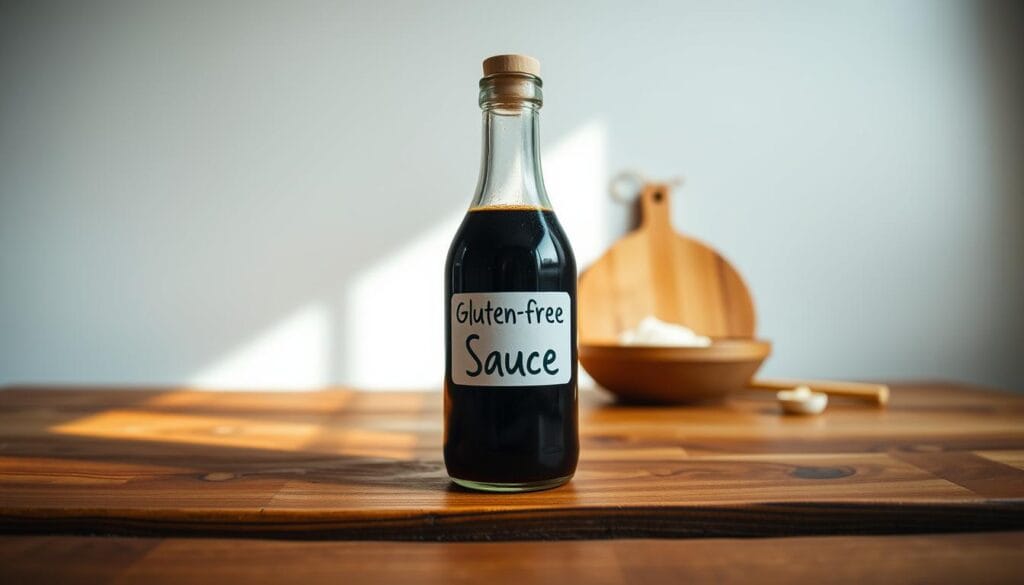Imagine making your own gluten-free soy sauce at home. You can use cremini mushrooms and salt to create a tasty, healthy sauce. It’s perfect for any dish and is also low in sodium.
Introduction to Gluten-Free Soy Sauce
Making gluten-free soy sauce is easy and only takes a few ingredients and patience. It takes about 8 days to ferment, and the best temperature is between 60°F to 80°F. This way, you can enjoy a gluten-free, low-sodium soy sauce that tastes just like the real thing.
Key Takeaways
- You can make your own gluten-free soy sauce at home with simple ingredients.
- The fermentation time for soy-less sauce is approximately 8 days.
- The ideal fermentation temperature range is between 60°F to 80°F.
- Gluten-free tamari is a great alternative to traditional soy sauce.
- Low sodium soy sauce options are available with this homemade recipe.
- You can customize your gluten-free soy sauce to your taste preferences.
Understanding Gluten-Free Soy Sauce
Traditional soy sauce is made from soybeans and wheat, so it’s not gluten-free. But, with more people following gluten-free diets, new options have come up. These include wheat free soy sauce and organic gluten free soy sauce. They offer a similar taste to regular soy sauce but without gluten.
Choosing gluten-free soy sauce lets you control what goes into your food. By picking non gmo soy sauce, you avoid additives and genetically modified organisms. This is great for those who care about their health.
Alternatives to regular soy sauce include tamari and coconut aminos. Tamari is a wheat free soy sauce with a deep, savory taste. Coconut aminos, made from coconut sap, has a sweeter flavor.
When looking for gluten-free soy sauce, always check the labels. Look for certifications like gluten-free or non-GMO. This way, you know you’re getting a product that fits your dietary needs. With so many organic gluten free soy sauce options, you can enjoy soy sauce’s flavor without harming your health.
Essential Ingredients for Your Homemade Sauce
To make the best gluten free soy sauce, you need some key ingredients. Cremini mushrooms and salt are used to make a tasty and healthy sauce. You can also add garlic, ginger, and sesame oil to boost the flavor.
When picking ingredients, think about their nutritional value and dietary impact. For example, low-sodium tamari can lower the sodium in your sauce. Adding honey or agave nectar can also balance the taste.
Here are some important ingredients for your homemade sauce:
* 1 cup water
* ¼ cup soy sauce
* 5 teaspoons packed brown sugar
* 1 tablespoon honey
* ½ teaspoon ground ginger
* ¼ teaspoon garlic powder
* 2 tablespoons cornstarch
* ¼ cup cold water
With these ingredients, you can make a delicious and healthy best gluten free soy sauce. It’s great for any dish. Feel free to try different ingredients and flavors to make your own unique soy sauce alternative.
Required Kitchen Tools and Equipment
To make your own gluten free condiments, like gluten free soy sauce, you need basic tools. You’ll need a wide-mouthed mason jar, a fermentation lid, and fermentation weights.
Making gluten free soy sauce requires the right tools. A fermentation lid helps create a tasty, healthy sauce. It tastes and feels like traditional soy sauce.
You might also want some extra tools for advanced recipes. Consider a work sharp rolling knife sharpener or a milk street precision rolling pin. These tools can add depth to your gluten free soy sauce.
| Tool | Description |
|---|---|
| Wide-mouthed mason jar | Used for fermentation and storage |
| Fermentation lid | Allows for controlled fermentation and flavor development |
| Fermentation weights | Helps to keep ingredients submerged during fermentation |
Investing in the right tools makes a big difference. You can make a tasty, healthy gluten free soy sauce. It’s great for any dish, whether simple or complex.
The Best Gluten-Free Soy Sauce Recipe
Making a tasty and healthy gluten-free soy sauce is easy with the right ingredients and a simple recipe. A good recipe will add flavor and health benefits to your meals. Plus, you can control the sodium and ingredients, which is great for those with dietary needs.
To start, you’ll need cremini mushrooms, salt, and water. You can also add garlic, ginger, and rice wine vinegar for extra flavor. This gluten-free teriyaki sauce takes just 5 minutes to make and lasts up to 2 weeks in the fridge.
- Combine all the ingredients in a saucepan and bring to a boil
- Reduce the heat and let it simmer for a few minutes
- Strain the sauce and let it cool
- Store it in the fridge and use it as needed
With this simple recipe, you can make a delicious and healthy homemade gluten-free soy sauce. It’s perfect for any dish and has less sodium and more flavor than traditional soy sauce.
Quick vs Traditional Fermentation Methods
When making homemade gluten free soy sauce, you have two main choices: quick and traditional. The quick method is faster, giving a simpler taste. The traditional method takes longer, creating a richer flavor.
The traditional method can take eight months or more. This allows for a deeper, more complex taste. On the other hand, quick methods might include chemicals like 3-MCPD. This chemical has been linked to health issues in animals.
Gluten free tamari is a good alternative. It’s 100% soy-based, making it safe for those with gluten allergies. Tamari is a great choice for those who need a gluten-free option.
Here is a comparison of the nutritional content of tamari and soy sauce:
| Nutrient | Tamari (per tablespoon) | Soy Sauce (per tablespoon) |
|---|---|---|
| Calories | 11 | 9 |
| Protein | 2g | 1g |
| Sodium | 1010mg | 878mg |
The choice between quick and traditional methods depends on your preferences. If you prefer a quicker process, the quick method might be better. But, if you’re willing to wait for a richer flavor, go for the traditional method.
Customizing Your Sauce’s Flavor Profile
Customizing your gluten-free soy sauce is a fun adventure. You can tweak the salt to make a low sodium version. Or, you can add ingredients to boost the flavor. If you’re after a wheat free soy sauce, you can mix and match to find your favorite taste.
Here are some tips to get you started:
- Adjust the salt content to your taste, keeping in mind that low sodium soy sauce is a popular option.
- Add complementary ingredients, such as garlic or ginger, to enhance the flavor of your wheat free soy sauce.
- Experiment with different ratios of ingredients to create a unique flavor profile.
By tweaking your sauce’s flavor, you can make a gluten-free soy sauce that’s just right for you. Whether you’re after a low sodium soy sauce or a wheat free one, the choices are endless. So, don’t hesitate to try new things and find the perfect flavor for your taste buds.
Storage Tips and Shelf Life
Storing your homemade gluten free soy sauce right is key to keeping it fresh. Unopened, it can last 2-3 years in a cool, dry spot. Once you open it, keep it in the fridge for up to 6 months to keep the taste good.
Gluten free condiments like soy sauce should be kept in the fridge to last longer. Watch out for changes in color, texture, or smell. A sour or bad smell means it’s gone bad.
Here are some tips for storing gluten free soy sauce:
- Keep it in a cool, dry place
- Refrigerate it after opening
- Look for signs of spoilage like bad smell or mold
By following these tips, you can enjoy your homemade gluten free soy sauce longer. Always check for spoilage before using it. Store it to keep its quality and taste.
It’s also important to know the type of soy sauce you have. Light Soy Sauce and Dark Soy Sauce have different shelf lives. Light Soy Sauce lasts like other soy sauces, while Dark Soy Sauce can last longer in the fridge because it’s used less.
Knowing how to store and how long your gluten free soy sauce lasts helps you enjoy it more. Whether you use it as a condiment or in recipes, proper storage keeps it tasting great.
Common Mistakes to Avoid
When making homemade gluten free soy sauce, it’s key to know common mistakes. These can ruin the sauce’s quality and taste. It’s important to steer clear of mistakes that can harm the sauce’s integrity.
Temperature Control Issues
Temperature control is crucial in making homemade gluten free soy sauce. If the temperature is off, it can cause bad flavors or spoilage. Keep a close eye on the temperature and aim for a steady environment.
Ingredient Ratios
Getting the right ingredient ratios is vital. Too much or too little of any ingredient can mess up the sauce’s taste and texture. Stick to a tested recipe and tweak the ratios to get the flavor just right.
Fermentation Problems
Fermentation issues can happen if the environment isn’t right for beneficial microbes. Make sure your space is clean and controlled, with the right temperature and humidity. By avoiding these mistakes, you can make a tasty and healthy homemade gluten free soy sauce.
Some common mistakes to watch out for when making homemade gluten free soy sauce include:
- Using low-quality ingredients
- Not monitoring the temperature and humidity levels
- Not following a tried-and-tested recipe
- Not adjusting the ingredient ratios as needed
Comparing Homemade vs Store-Bought Options
When it comes to gluten free soy sauce, you have two main options: homemade and store-bought. Both have their good and bad sides. Store-bought gluten free tamari is easy to find, but it might have extra preservatives and sodium. Homemade gluten free soy sauce lets you pick the ingredients and control the sodium.
Cost is a big factor when choosing between homemade and store-bought. Store-bought gluten free soy sauce might seem pricey, but making your own can save money over time. This is especially true if you buy ingredients in bulk.

Some popular store-bought choices include gluten free tamari and coconut aminos. These can replace traditional soy sauce and taste similar. When buying store-bought, always check the labels for low-sodium and gluten-free certifications.
In conclusion, the choice between homemade and store-bought gluten free soy sauce depends on what you prefer and need. By weighing the pros and cons of each, you can pick what’s best for you and your diet.
Health Benefits of DIY Gluten-Free Soy Sauce
Making your own gluten-free soy sauce has many health perks. You get to pick the ingredients, avoiding additives and preservatives. This is great for those on a gluten-free diet. You can also tailor the flavor to your taste.
Homemade gluten-free soy sauce can be more nutritious. You can choose ingredients rich in protein, fiber, and nutrients. For example, using whole soybeans makes the sauce more nutritious. The fermentation process also makes these nutrients easier for your body to use.
Some key benefits of homemade gluten-free soy sauce include:
- Lower sodium content: You can control the salt, making it less salty.
- Higher protein content: Using whole soybeans or other high-protein ingredients makes it more protein-rich.
- Increased fiber content: Adding fiber-rich ingredients boosts the sauce’s fiber.
Making your own gluten-free soy sauce is a smart choice. It offers a healthier option with a richer nutritional profile and less sodium. It’s perfect for those who want to make a healthier choice while enjoying a tasty sauce.
Using Your Homemade Sauce in Recipes
Now that you’ve made your own homemade gluten free soy sauce, it’s time to get creative. Use it in various recipes to make your dishes more delicious. It’s especially great in marinades and dips.
For instance, use it as a marinade for chicken, beef, or tofu. It adds a rich flavor that makes your dishes stand out. You can also dip vegetables like carrots, cucumbers, or bell peppers for a tasty snack.
But it’s not just for marinades and dips. You can also use it in stir-fries, braises, or sauces. The possibilities are endless. With a bit of experimentation, you can create unique gluten free soy sauce recipes that will wow your family and friends.
Here are some ideas for using your homemade sauce:
* Season noodles or rice with it
* Add it to soups or stews for extra flavor
* Use it as a sauce for grilled meats or veggies
* Mix it with other ingredients to make a unique dressing or marinade
Troubleshooting Common Issues
When making homemade gluten free soy sauce, you might face some common problems. These can change the taste and quality of your sauce. Let’s look at some common issues and how to solve them.
One big problem is contamination during fermentation. To avoid this, use clean tools and containers. Another issue is off-flavors, which can come from bad ingredients or wrong fermentation methods.

To beat these challenges, stick to a reliable recipe and use top-notch ingredients. You can also tweak the fermentation time or temperature to get the flavor you want. By doing these things, you can make a tasty and healthy gluten free soy sauce for any meal.
Other common problems you might face include:
- Insufficient fermentation time, leading to weak or bland flavor
- Over-fermentation, causing strong or sour taste
- Contamination with gluten, if you’re not careful with ingredients and tools
Knowing these issues and how to prevent them helps you make a great homemade gluten free soy sauce. It’s perfect for your cooking needs.
Conclusion
Making your own gluten-free soy sauce at home is rewarding and empowering. You can now make a gluten-free soy sauce that fits your diet and taste. Whether you choose a quick method or traditional fermentation, you’ll get a tasty, healthy sauce.
Living gluten-free doesn’t mean you have to give up flavor. This guide has given you the tools to make a delicious, umami-rich sauce at home. Enjoy using your homemade sauce in marinades, dips, and more. You’ll know you’re feeding your body with healthy, gluten-free ingredients.
FAQ
What makes traditional soy sauce non-gluten free?
What are the benefits of homemade gluten-free soy sauce alternatives?
What are the common ingredients used in gluten-free versions of soy sauce?
What are the essential ingredients for homemade gluten-free soy sauce?
What kitchen tools and equipment are needed to make homemade gluten-free soy sauce?
What are the steps for the best gluten-free soy sauce recipe?
What are the differences between the quick and traditional fermentation methods for homemade gluten-free soy sauce?
How can you customize the flavor profile of your homemade gluten-free soy sauce?
How should homemade gluten-free soy sauce be stored to extend its shelf life?
What are some common mistakes to avoid when making homemade gluten-free soy sauce?
How do homemade and store-bought gluten-free soy sauce options compare?
What are the health benefits of making homemade gluten-free soy sauce?
How can homemade gluten-free soy sauce be used in recipes?
What are some common issues that can arise when making homemade gluten-free soy sauce, and how can they be troubleshooted?
Table of Contents
Did you like this recipe?
There are no reviews yet. Be the first one to write one.

